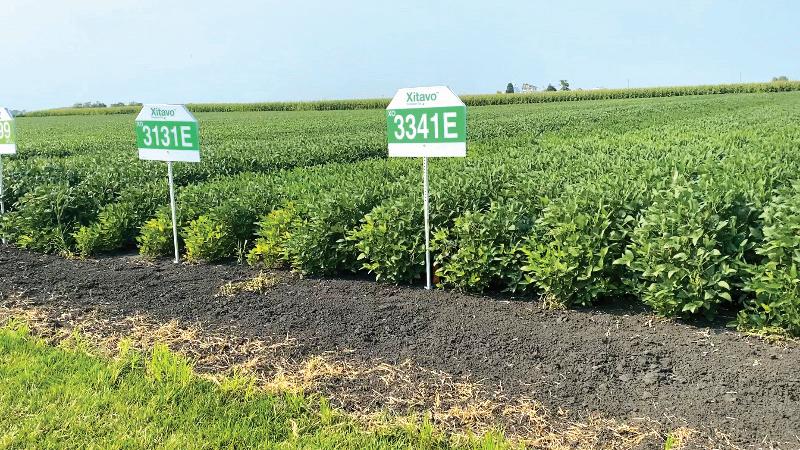Trait Choice, New Support Around Seed Driving the ’21 Market

Having more choices is a good problem — but navigating dicamba uncertainty and COVID weigh on the retail seed business. Photo credit: BASF
For growers and ag retailers, 2020 was about survival.
“We went through Covid, dicamba, and then trying to get things planted with the weather — we had drought and prevent plant acres in some areas,” Ryan Wolf, WinField United Agronomist, said. “As we put 2020 in the books, we need to look back and evaluate what went well and what didn’t go so well and re-evaluate how we are going to get to the yield goals we want to realize in 2021.”
About 28% of the nation’s top ag retailers say that their seed sales have suffered thus far during the growing season, according to the CropLife 100 Mid-Year Survey, and overall seed sales are expected to be down about 2%, from $4.8 billion to $4.7 billion for 2020.
Seed has continued to chug along as a share of retail revenue, climbing from 9% in 2001 to 15% in 2020 among CropLife 100 retailers but has been relatively stagnant for nearly a decade.
But first, some good news: EU’s approval of Bayer’s XtendFlex beans in late September gave the industry a bit of much-needed clarity. Bayer said it will launch XtendFlex beans, which confer tolerance to glufosinate, dicamba, and glyphosate, in the U.S. and Canada in 2021 and it expects to be in a strong position to supply 20 million U.S. soy acres when the selling season arrives.
On dicamba, EPA has yet to issue its decision on the label for 2021 as of this writing, although it was expected to do so by mid-October.
“We feel very confident in our system and submission and feel really good about 2021 and having the full system available,” Alex Zenteno, Bayer Dicamba Product Manager, told CropLife®.
BASF was not alone in its mention of seeing increased demand for both its LibertyLink GT27 and Corteva-owned Enlist E3 technologies, partly because of uncertainty around dicamba.
“Right or wrong, I think growers are looking at what they know is true today and what they can use with respect to their herbicide programs and trait platforms,” Marc Hoobler, BASF U.S. Soybean Agronomy Lead, said.
Beyond the dicamba factor, one of the big takeaways from 2020 was Corteva’s Enlist E3 trait coming to market, giving farmers more options on weed control while making decisions that much tougher. As Hoobler pointed out: “It’s a tremendous time to be a soybean grower.”

To help meet demand for E3 seed, BASF acquired distribution rights to MS Technologies’ Xitavo brand. Photo credit: BASF
Over the past season, Enlist E3 seed supply came up as a frequent concern, but for 2021, it looks to be a non-issue. BASF put a robust plan in place, including launching 19 varieties of the Xitavo brand, MS Technologies’ Enlist E3-traited soybeans, of which BASF is the exclusive distributor, as well as with LibertyLink GT27 in its Credenz brand. “We feel very confident in the maturities that we are participating in that will have adequate supply to meet the market demand,” Hoobler said.
“Really what we’re seeing is the primary foundation trait in all of these platforms moving forward is tolerance to Liberty herbicide,” he said. “That’s the kingpin as we move forward with Enlist E3.”
“Trait choice is what drove our momentum in 2020, and as we go into 2021, that trait choice we can bring to our retail partners is why we have momentum,” Jim Shertzer, Head of NK Marketing for Syngenta North America, said. “It will be a dynamic market over the next couple of months, and it’s really important that we stay close to our customers to help them navigate through seed decisions, because there’s confusion out there as well.”
Syngenta has come up with an innovative way to help its retail partners make tricky seed recommendations through its new online Cropwise Seed Selector, which delivers unbiased, fact-based assessments of NK Seeds product performance. An archive of agronomic information allows users of the tool to tailor their seed portfolio based on things like geographic location, soil productivity, precipitation levels, historic crop stress, and performance of products by year and region. Users can adjust these factors to understand how a specific corn hybrid or soybean variety would perform under an array of different conditions.
“The feedback (from retail partners) we’ve gotten is that it provides a ton of value for them,” Shertzer said. “They see it as a way to help them make sure they’re placing products in the right spot, which ultimately creates a good experience and helps the retailer retain and grow that customer. It helps continue to build that trusted adviser role that our retail partners play with their customers.”
Year of the Warranty
With no shortage of commodity price-killing demons to battle, not to mention the holding pattern around the future of the dicamba-based Xtend system, 2020 has been an excellent year to launch a hodgepodge of warranty programs, not limited to dicamba products. And that, seed companies did.
“I think you’re seeing a shift in the farmer’s mindset, that they want to share risk out there a little bit. I think this brings in some new ways of thinking in how we share risk going forward,” Wolf said.
Bayer, most notably, declared its “2021 Plant With Confidence Offer” in August, providing growers who purchase XtendFlex beans with a $3 per unit price reduction and a $7 per unit price reduction on Xtend beans, in the event that they are unable to spray XtendiMax based on EPA’s decisions.
Syngenta rolled out a small pilot this year of the AgriClime weather protection program, which is built into qualifying Syngenta purchases and offers returns up to 30% on those purchases in the event of certain adverse weather conditions during key growth stages. It also extended a pilot of its NK Assurance program, which guarantees yield at a certain percentage of a grower’s five-year actual production history (APH).
“We expect the programs to be a much bigger piece of our marketing programs in 2022,” Shertzer told CropLife. “We have found there are a couple groups of growers that this (warranty) type of approach fits them better than some other ways we’ve marketed our seed to them in the past … Some want nothing to do with it, and others get interested really quickly.”
According to Shertzer, helping its retail partners learn how to position the programs so they’re leveraging them in the right way has been integral to ensuring the new program’s success. “It’s just a different way to approach the grower, but if done right it can be powerful.”
WinField United has also been experimenting with warranties on its Answer Plot-based seed and crop protection prescriptions in a program called Advanced Acre Rx for the last two years. Its slogan: “Get with the program. Get 95% of your APH. Or get money back.” Such warranty programs are set to become more widespread in 2021.
The move to warranties on seed has not been without its problems, however. According to Wolf, some retailers challenged it initially because the programs break out products and services, flouting the norm of seamless packages with services built into the price. “Price transparency has become very clear in the marketplace here in the last couple of years.”
He clarified that the intention is not to cut dealers out — just the opposite. “We’re working with them hand in hand. It’s just a different thought process for a lot of dealers to think about, and growers, too … We have crop insurance and things like that, but they really haven’t thought about a warranty in the past.”
Jim Hedges, WinField United Vice President of Seed, pointed out that Answer Plot is not just trialing hybrid performance in different environments, but it also ties in management. “For instance, our data shows 67% of hybrids have a moderate or high response to fungicides. We drive that same data on nitrogen,” he said. “Because we can write these prescriptions, the reinsurance company looks at the data and understands that we’re taking the odds up on yield.” This year, WinField United ran a fungicide warranty that guaranteed 105% of APH.
Warranty programs ultimately enable the grower to continue to invest in their crop even when commodity prices are low because there’s a highly predictable positive ROI on that choice, thanks to the data, he said. “It’s really putting your money where your mouth is.”
Brevant Update
Recall the seed shakeup that came in the spring, with Corteva Agriscience’s announcement it would replace its Mycogen brand with Brevant and shift its market approach to 100% agricultural retail. As my wiser colleague Paul Schrimpf tells it, the evolution of seed sales toward ag retail has been an excruciating one.
Besides Monsanto (now Bayer), “the rest of the industry either stayed out entirely or danced in the margins, reticent to upset farmers who would likely punish any brand that would compromise their existing seed sales relationship,” Schrimpf wrote back in May, adding, “Corteva’s shift to bring the newly branded Brevant seed line into the exclusive control of ag retail is a hopeful sign.”
In mid-October, we had a chance to catch up with Brian Barker, Corteva’s Commercial Unit Leader for Multichannel Seeds, for an update on the move and to learn more about what it has in store for the 2021 season in seed. From all indications, Corteva along with its retail partners across the Midwestern Corn Belt — where it focused efforts with Brevant — have pulled off the brand pivot and go-to-market approach well, especially considering the timing.
“We launched a brand-new brand right in the middle of a global pandemic, so that’s always fun,” Barker joked. “But it went extremely well. We had a lot of executive input from retail organizations in putting together the plan, so we didn’t do it in a vacuum.”
Barker described the path to the launch including the retooling of its product portfolio over the last two years. “Everybody is in the combines right now, and the performance results of the products have been very strong,” he said. “We were with a major retailer last Thursday, and results from the portfolio are coming back very, very strong. It looks like all the pieces are in place now.”
He remarked that the company kept some of the most established, best performing assets of the Mycogen line, specifically its corn silage products, but don’t listen to anyone who says Brevant is a rebranding of Mycogen. “Brevant is a new seed company with a new look and new feel and new structure and new product portfolio that is designed for retail based on their inputs, and we’ve been building this for a while.”
Integral to its pivot to retail was the concerted effort to work through ag retailers, instead of trying to be out in front of them. “We rely on retail’s sales force, agronomy force, etc. We designed our organization to pair with that, and to use their teams and resources, because it’s one of the pieces of feedback we received,” he related of the retailers’ desire for support with the hefty demands on their time and knowledge required to sell seed on top of everything else. “It is very much through the retail organization, which is different than the past where you were trying to push and pull demand through.”
Looking to 2021, Corteva expects that retail partners will be taking a broader, more aggressive position on Brevant upon seeing performance and data, especially on corn with its headliner Qrome rootworm trait package. “They’re starting to see (the results) really pop, so that gives them a lot of confidence,” in addition to the appeal of more new products the company will be adding to the lineup.
On the soybean side, Corteva has heavily transitioned over to E3 in all its brands. “We’re getting strong uptake from retail — our orders are well ahead year on year,” Barker said. “We think Enlist is going to be bigger and broader than last year, and we’ll see what happens with the dicamba labels, but we think Enlist is going to grow in its share out there in the marketplace.”






